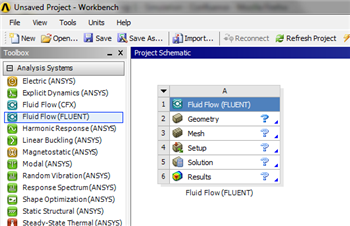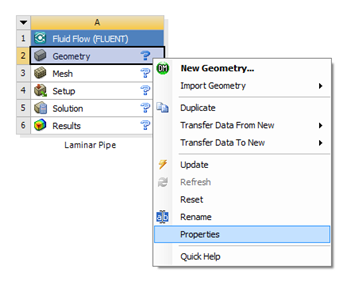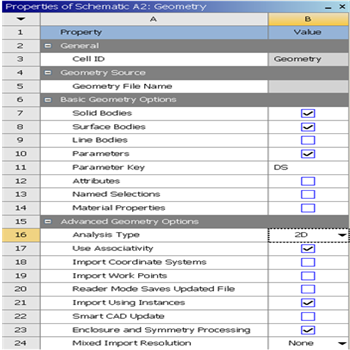| Panel |
|---|
Problem Specification |
Step 2: Geometry
| Info | ||
|---|---|---|
| ||
If you would prefer to skip the geometry and mesh steps, then you can download the necessary files here. Download the "zip" file, then extract the files to your working directory. In order to load the necessary files, go to the Workbench Project Page, then (Click) File > Open > "pipe_laminar.wbpj". Lastly, click here to skip ahead to Step 4 of the tutorial. |
Saving
It would be of best interest, to save the project at this point. Click on the "Save As.." button, , which is located on the top of the Workbench Project Page. Save the project as "LaminarPipeFlow" in your working directory. When you save in ANSYS a file and a folder will be created. For instance if you save as "LaminarPipeFlow", a "LaminarPipeFlow" file and a folder called "LaminarPipeFlow_files" will appear. In order to reopen the ANSYS files in the future you will need both the ".wbpj" file and the folder. If you do not have BOTH, you will not be able to access your project.
Fluid Flow(FLUENT) Project Selection
On the left hand side of the workbench window, you will see a toolbox full of various analysis systems. To the right, you see an empty work space. This is the place where you will organize your project. At the bottom of the window, you see messages from ANSYSSince our problem involves fluid flow, we will select the FLUENT component on the left panel.
Left click (and hold) on Fluid Flow (FLUENT), and drag the icon to into the empty space in the Project Schematic. Here's what you get:
Your ANSYS window should now look comparable to the image below.
Since we selected Fluid Flow(FLUENT), each cell of the system corresponds to a step in the process of performing CFD analysis using FLUENT. Rename the project to Flat Plate Boundary LayerLaminar Pipe.
We will work through each step from top down to get to obtain the solution to our problem.
Analysis Type
In the Project Schematic of the Workbench window, right click on Geometry and select Properties. You will see the properties menu on , as shown below.
The properties menu will then appear to the right of the Workbench window. Under Advance Geometry Options, change the Analysis Type to 2D as shown in the image below.
Launch Design Modeler
In the Project Schematic, double left click on Geometry to start preparing the geometry. After you launch the web tutorials and FLUENT, you will have to drag the browser window to the width of the largest image (about 350 pixels). To make best use of screen real estate, move the windows around and resize them so that you approximate
At this point, a new window, ANSYS Design Modeler will be opened. You will be asked to select desired length unit. Use the default meter unit and click OK.
Creating a Sketch
Start by creating a sketch on the XYPlane. Under Tree Outline, select XYPlane, then click on Sketching right before Details View. This will bring up the Sketching Toolboxes.
| newwindow | ||||
|---|---|---|---|---|
| ||||
https://confluence.cornell.edu/download/attachments/123547957/Select+Sketching+Toolboxes.gif |
Click on the +Z axis on the bottom right corner of the Graphics window to have a normal look of the XY Plane.
| newwindow | ||||
|---|---|---|---|---|
| ||||
https://confluence.cornell.edu/download/attachments/111221570/Select+Normal+View.gif |
In In the Sketching toolboxes, select Rectangle. In the Graphics window, create a rough rectangle starting from Rectangle by clicking once on the origin and then by clicking once somewhere in the positive XY direction (The letter P that shows up when you point the cursor on the origin means that the the point is coincident to the origin)
You should have something like this:
...
Dimensions
Now we will specify the appropriate dimensions and constraints. Below is the summary of geometry flat plate boundary layer:
Length: 1 m
Height: 0.5m (another suitable value can be used)
plane. (Make sure that you see a letter P at the origin before you click. The P implies that the cursor is directly over a point of intersection.) At this point you should have something comparable to the image below.
Dimensions
At this point the rectangle will be properly dimensioned.
Under Sketching Toolboxes, select Dimensions tab, use the default dimensioning tools. Then click on the lines and drag upwards or sideways as the case may be to place the dimensions
Now that we have the sketch done, we can create a surface for this sketch.
Then click on Concept tab in the Design modeler window, then click on Surface from sketches.
Dimension the geometry as shown in the following image.
| newwindow | ||||
|---|---|---|---|---|
| ||||
https://confluence.cornell.edu/download/attachments/85624044/Dim_Full.png |
Under the Details View table (located in the lower left corner), set V1=0.1m and set H2=8m, as shown in the image below.
| newwindow | ||||
|---|---|---|---|---|
| ||||
https://confluence.cornell.edu/download/attachments/85624044/DetViewDim_Full.png |
Surface Body Creation
In order to create the surface body, first (Click )Concept > Surface From Sketches as shown in the image below.
This will create a new surface SurfaceSK1. Under the Tree Outline, click on the X-Y Plane and Details View, select Sketch1 as Base Objects and under Details View, click Applythen under Surface body select the thickness to 0.1m and click Apply. Finally click Generate to generate the surface.
This shown below:
At this point, you can close the Design Modeler and go back to Workbench Project Page. Save your work thus far in the Workbench Project Page.
Go to Step 3: Mesh
 Sign-up for free online course on ANSYS simulations!
Sign-up for free online course on ANSYS simulations!






